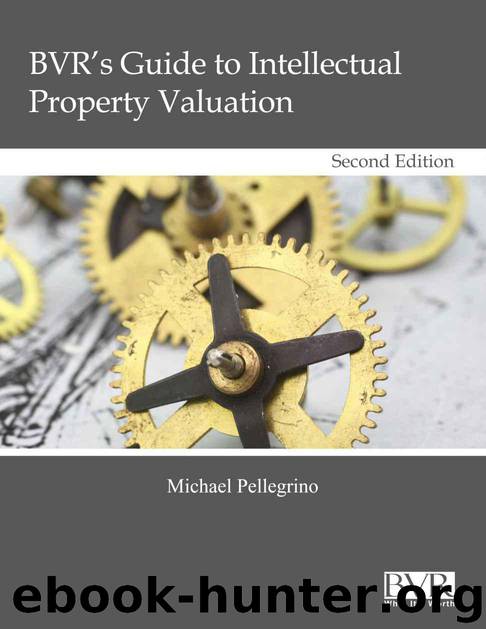BVR's Guide to Intellectual Property Valuation by Michael Pellegrino

Author:Michael Pellegrino [Pellegrino, Michael]
Language: eng
Format: mobi
Tags: auditor’s review guide, discount rate development, trade secrets, intellectual property, valuation approaches, managing an engagement, due diligence, intellectual property valuation, copyrights, trademarks, valuation guidance, royalty rates, patents
Publisher: Business Valuation Resources, LLC
Published: 2012-04-08T14:00:00+00:00
And the same USPTO report offers the statistics in Exhibit 72 for inter partes reexaminations.
As the data suggests, an increasing number of reexaminations originate from a related dispute on patentability. The statistics surrounding success in reexaminations should be of importance to the IP valuation analyst performing a patent valuation. The USPTO report gives the statistics in Exhibit 73 for ex parte reexaminations.
As the data demonstrates, a patent claim under an ex parte reexamination statistically has a 49% chance of affirmation (i.e., the breadth of the patent’s claimed inventions remain intact), 52% including cases dismissed. However, it has a 14% chance of only partial affirmation, and a 30% chance of complete reversal. On an expected value basis, if a patent claim is under review in an ex parte reexamination with the USPTO, the expected value may be as high as 44% that the USPTO would reject a key patent claim. Thus, a patent nominally worth $100 that is in the midst of an ex parte reexamination would have an expected value of $51.50 after accounting for the probability of a rejection of a key patent claim.
For inter partes reexaminations, the statistics are even more in favor of the petitioner. One author tracked the results of 83 inter partes reexaminations and found that the USPTO confirmed all patent claims were novel in only 1% of the patents.126 It rejected and cancelled all claims in 71% of the patents, and required claim changes in 28% of the patents.127 Thus, on an expected value basis, a patent stands to have a higher impairment (at least 71%) if a third party requests an inter partes reexamination of the patent under review.
Given that the USPTO grants most ex parte and inter partes reexamination requests, and given the reversal rate for key patent claims, the chances of patent value impairment once a reexamination process begins is high. As a result, if the USPTO grants a reexamination request, the patent owner may feel increased pressure to negotiate a deal, even if it is less favorable to the patent owner than it otherwise would be. This may lead to a lower patent value. When the USPTO grants a reexamination request, the patent owner has an increased risk that there will be no future cash flows attributable to the patent under review. The IP valuation analyst performing a patent valuation should explicitly account for such probabilities in the valuation model.
Declaratory Judgments of Invalidity or Unenforceability
While declaratory judgments can be of use to a patent owner, reducing the risk associated with a royalty or injunction relating to a blocking patent, they can be disastrous to value when the patent under review is the subject of a declaratory judgment of invalidity or unenforceability. Recall that a declaratory judgment is a court decision in a civil case that instructs parties on their rights and responsibilities to help parties dispute or resolve a legal uncertainty. Author Richard Stim identifies circumstances that may give rise to a declaratory judgment of invalidity:128
Download
This site does not store any files on its server. We only index and link to content provided by other sites. Please contact the content providers to delete copyright contents if any and email us, we'll remove relevant links or contents immediately.
You Don't Own Me by Orly Lobel(1145)
Hello, My Name is Awesome by Alexandra Watkins(1085)
Intellectual Property Strategy by John Palfrey(1082)
Without Copyrights by Spoo Robert(978)
Democracy of Sound by Alex Sayf Cummings(962)
Profit From Your Idea: How to Make Smart Licensing Deals by Attorney Richard Stim(941)
World War 3.0 by Ken Auletta(905)
A Triumph of Genius: Edwin Land, Polaroid, and the Kodak Patent War by Ronald K. Fierstein(903)
The Trademark Guide by Lee Wilson(894)
Kafka's Last Trial by Benjamin Balint(847)
Data Protection: A Practical Guide to UK and EU Law by Carey Peter(842)
Patent It Yourself: Your Step-by-Step Guide to Filing at the U.S. Patent Office by Pressman David Attorney(822)
What They'll Never Tell You About the Music Business by Peter M. Thall(818)
Mass Media Law by Pember Don & Pember Don(811)
BVR's Guide to Intellectual Property Valuation by Michael Pellegrino(810)
Hello, My Name Is Awesome: How to Create Brand Names That Stick (BK Business) by Alexandra Watkins(809)
The Tech Contracts Handbook: Software Licenses and Technology Services Agreements for Lawyers and Businesspeople by David Tollen(793)
The Copywriter's Handbook by Robert W. Bly(786)
The New Censorship: Inside the Global Battle for Media Freedom by Joel Simon(769)
